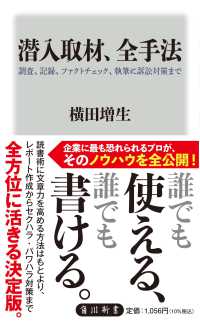- ホーム
- > 洋書
- > 英文書
- > Science / Mathematics
Full Description
Simulating Protein Folding in Variable Environmental Conditions: Transformation from Globular Proteins to Amyloids delves into the effects of external conditions upon the protein folding process. It considers how this can lead to amyloid formation and why proteins fold the way they do. The book presents the fuzzy oil drop model (FOD-M), which enables the measurements of external factors influencing the folding process and considers changed external conditions as the source for the misfolding process. It begins with an introduction to amyloid transformation and outlines the hypothesis of the model simulation before considering the role of environmental factors, including the water environment and membrane environment. This book is a useful resource for researchers interested in investigating protein folding across molecular biology, structural biology, biochemistry, computational biology and related fields.
Contents
Part I: The amyloid transformation
1. The hypothesis - the biochemistry of amyloids
2. Three examples of different scenarios of amyloid transformation
Part II: Role of local environment in proteins structurization
3. Water environment
4. Membrane environment
5. General universal form to express the external force field
Part III: Local environment representation in programs oriented on protein structure prediction
6. Presentation of protocol for In Silico folding simulation Part IV: Specificity of secondary structure in amyloids
7. Analysis of secondary structure specificity as it appears in amyloids
Part V: The complete spectrum of environment influence (external force field) on protein folding
8. The examples of protein representing the micelle-like construction
9. The examples of proteins with participation of external force field in moderate degree
10. The trans-membrane proteins as examples of high influence of local environment on protein structurization
11. Enzymes - their protein body - as objects delivering the local external force field for catalytic reaction
12. Folding in assistance of chaperonin, chaperon, prefoldin - analysis as expressed by FOD-M model
Part VI: Alternative models for amyloid interpretation
13. Alternative models








